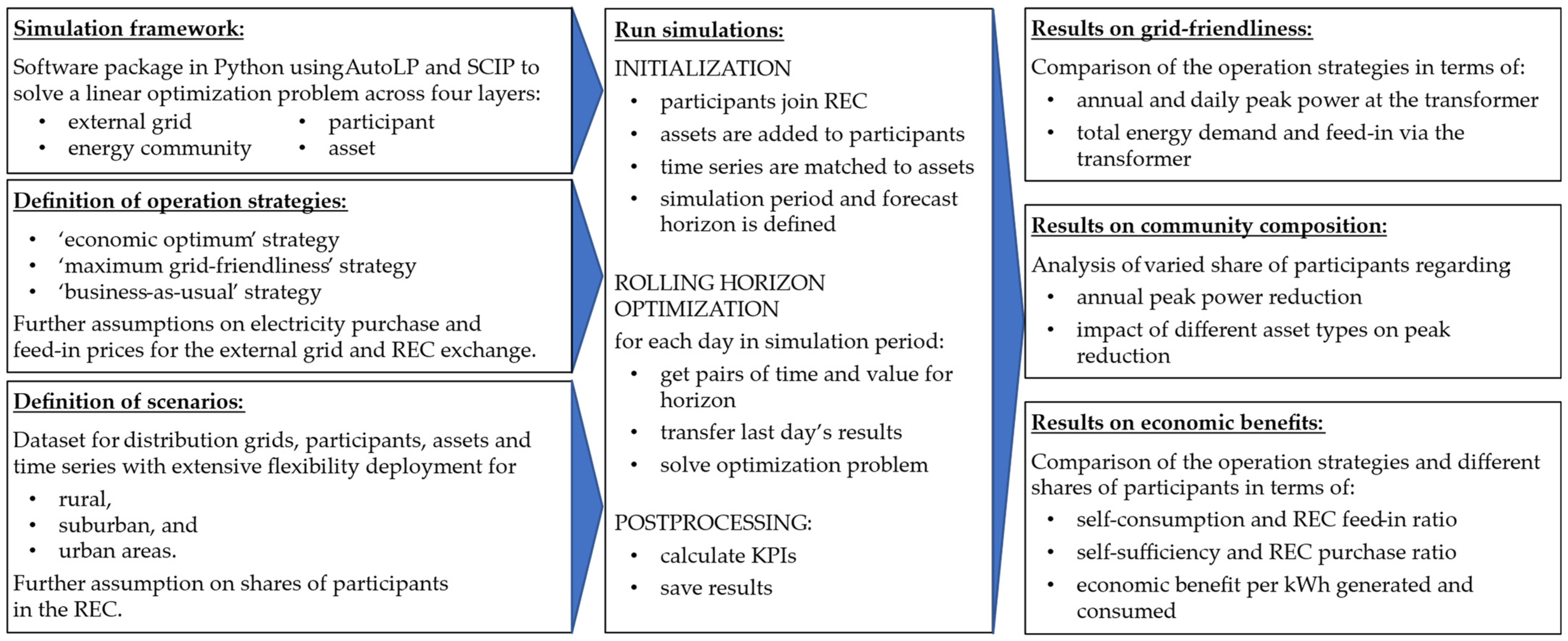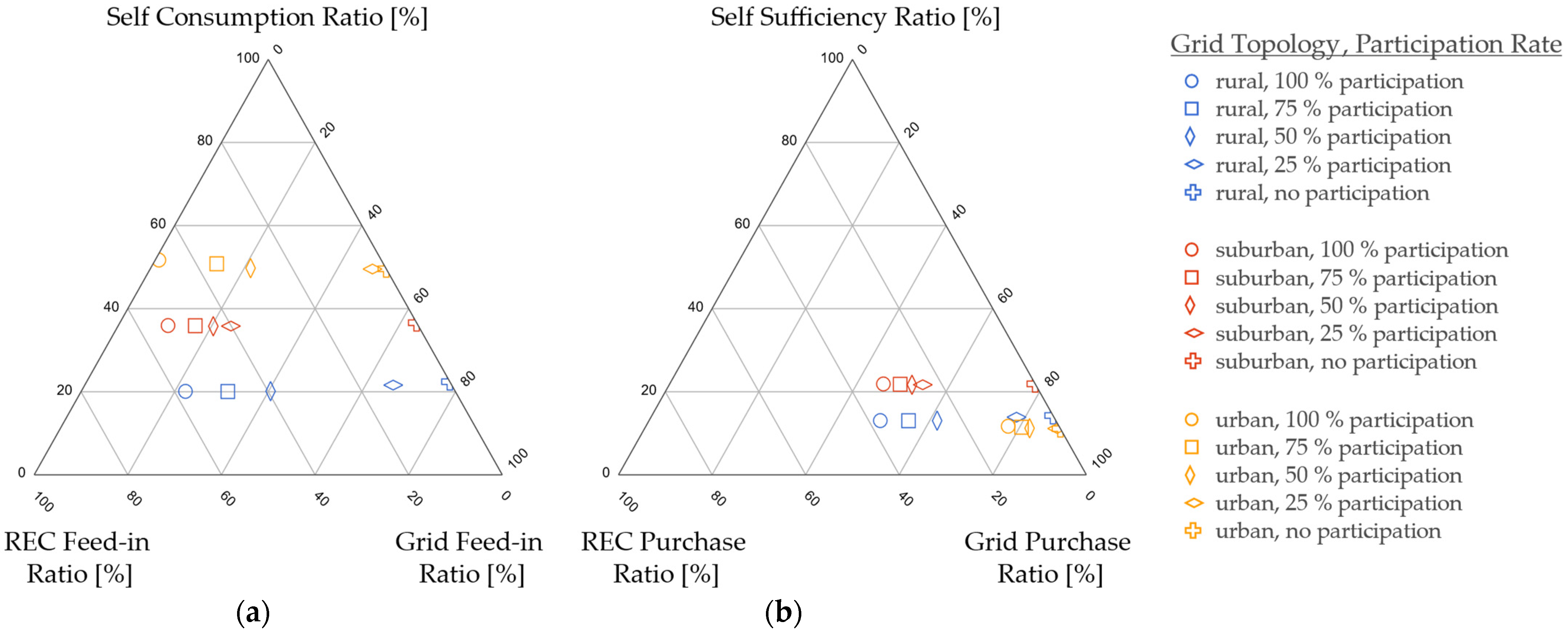Operating Renewable Energy Communities to Reduce Power Peaks in the Distribution Grid: An Analysis on Grid-Friendliness, Different Shares of Participants, and Economic Benefits
Abstract
:1. Introduction
1.1. Related Studies
1.2. Scope of This Work
2. Method
2.1. Simulation Framework for the Renewable Energy Community and Its Participants
2.2. Definition of Operation Strategies of the Renewable Energy Community and Its Participants
- The ‘economic optimum’ strategy focuses solely on the interests of the participants by minimizing the cost of demand and the profit from generation.
- The ‘maximum grid-friendliness’ strategy leverages the flexibility of the community for an approach that minimizes the annual transformer peak power.
- The ‘business-as-usual’ strategy provides a comparison and describes the operation of participants’ energy systems without REC participation and optimization.
2.3. Definition of Scenarios
2.4. Evaluation Metrics
3. Results
3.1. Renewable Energy Communities Targeting an Economic Optimum and Maximum Gird-Friendliness
3.2. Peak Demand Limiting Considering Different Shares of Participants
3.3. Economic Benefits and Incentives Required for Grid-Friendly Operation of Renewable Energy Communities
4. Discussion
4.1. Limitations
4.2. Future Research Directions
5. Conclusions
Author Contributions
Funding
Institutional Review Board Statement
Informed Consent Statement
Data Availability Statement
Acknowledgments
Conflicts of Interest
Abbreviations
| DSO | Distribution System Operator |
| EU | European Union |
| EV | Electric Vehicle |
| LP | Linear Programming |
| LV | Low Voltage |
| PV | Photovoltaic |
| REC | Renewable Energy Community |
| RED | Renewable Energy Directive |
| SME | Small and Medium-sized Enterprises |
| Variables: | |
| a | availability |
| B | economic benefit |
| specific cost, specific peak cost | |
| C | storage capacity, total cost |
| E | energy |
| GFR | grid feed-in ratio |
| GPR | grid purchase ratio |
| η | efficiency |
| power, peak power | |
| self-discharge coefficient | |
| R² | coefficient of determination |
| RECFR | REC feed-in ratio |
| RECPR | REC purchase ratio |
| SCR | self-consumption ratio |
| SOC | state of charge |
| SSR | self-sufficiency ratio |
| t, T, Δt | time step, simulation period, simulation time step interval |
| x | shares of participants |
| Indices: | |
| base load | aggregation of base loads |
| BAU | business-as-usual scenario |
| buy | energy purchase |
| charge | storage charging |
| consumption | energy consumption |
| curtailment | curtailment of generation |
| demand | energy/power demand |
| discharge | storage discharging |
| downstr. charge | charging of a downstream storage asset |
| feed-in | energy/power feed-in |
| flex. load | flexible loads |
| generation | generation asset |
| grid | exchange with external grid |
| int. conversion | internal conversion from ‘renewable electricity only’ to ‘electricity’ category |
| max. charge | maximum charging power of storage |
| max. discharge | maximum discharging power of storage |
| p | participant index |
| rated | nominal asset power |
| REC | exchange with Renewable Energy Community |
| self-discharge | storage loss by self-discharge |
| sell | energy sale |
| storage | storage asset |
| t | time step index |
References
- European Commission. The European Green Deal; European Commission: Brussels, Belgium, 2019. [Google Scholar]
- European Commission. REPowerEU: Joint European Action for More Affordable, Secure and Sustainable Energy; European Commission: Strasbourg, France, 2022. [Google Scholar]
- European Commission. EU Solar Energy Strategy; European Commission: Brussels, Belgium, 2022. [Google Scholar]
- The DfT and BEIS. COP26 Declaration: Zero Emission Cars and Vans; The DfT and BEIS: Glasgow, UK, 2021. [Google Scholar]
- Thormann, B.; Kienberger, T. Evaluation of Grid Capacities for Integrating Future E-Mobility and Heat Pumps into Low-voltage Grids. Energies 2020, 13, 5083. [Google Scholar] [CrossRef]
- Navarro-Espinosa, A.; Ochoa, L.F. Probabilistic Impact Assessment of Low Carbon Technologies in LV Distribution Systems. IEEE Trans. Power Syst. 2016, 31, 2192–2203. [Google Scholar] [CrossRef]
- Wolisz, H.; Punkenburg, C.; Streblow, R.; Müller, D. Feasibility and Potential of Thermal Demand Side Management in Residential Buildings Considering Different Developments in the German Energy Market Q. Energy Convers. Manag. 2016, 107, 86–95. [Google Scholar] [CrossRef]
- López, M.A.; De Torre, S.; Martín, S.; Aguado, J.A. Electrical Power and Energy Systems Demand-Side Management in Smart Grid Operation Considering Electric Vehicles Load Shifting and Vehicle-to-Grid Support. Int. J. Electr. Power Energy Syst. 2015, 64, 689–698. [Google Scholar] [CrossRef]
- Venegas, F.G.; Petit, M.; Perez, Y. Active Integration of Electric Vehicles into Distribution Grids: Barriers and Frameworks for Flexibility Services. Renew. Sustain. Energy Rev. 2021, 145, 111060. [Google Scholar] [CrossRef]
- Parag, Y.; Sovacool, B.K. Electricity Market Design for the Prosumer Era. Nat. Energy 2016, 1, 16032. [Google Scholar] [CrossRef]
- European Parliament DIRECTIVE (EU) 2018/2001 OF THE EUROPEAN PARLIAMENT AND OF THE COUNCIL of 11 December 2018 on the Promotion of the Use of Energy from Renewable Sources. Off. J. Eur. Union 2018, 2018, 82–209.
- Bundesministerium für Klimaschutz Umwelt Energie Mobilität Innovation und Technologie Erneuerbaren-Ausbau-Gesetz. In 733 der Beilagen zu den Stenogr. Protok. des Natl. XXVII. GP; Bundesgesetzblatt: Vienna, Austria, 2021; pp. 1–97.
- Ministerio para la Transición Ecológica RD 244/2019, 5 Abril, Por El Que Se Regulan Las Condiciones Administrativas, Técnicas y Económicas Del Autoconsumo de Energía Eléctrica. Boletín Of. Del Estado 2019, 6, 35674–35719.
- Conselho de Ministros Decreto-Lei No 162/2019. In Diário da República, 1.a série N.o; Presidência do Conselho de Ministros: Lisboa, Portugal, 2019; pp. 45–62.
- Repubblica Italiana Testo Coordinato Del Decreto-Legge 30 Dicembre 2019, n. 162. In Gazz. Uff. Della Repubb. Ital; Ufficio Pubblicazione Leggi e Decreti: Rome, Italy, 2019; pp. 1–84.
- Mendicino, L.; Menniti, D.; Pinnarelli, A.; Sorrentino, N.; Vizza, P.; Alberti, C.; Dura, F. Dso Flexibility Market Framework for Renewable Energy Community of Nanogrids. Energies 2021, 14, 3460. [Google Scholar] [CrossRef]
- Märzinger, T.; Österreicher, D. Supporting the Smart Readiness Indicator-A Methodology to Integrate a Quantitative Assessment of the Load Shifting Potential of Smart Buildings. Energies 2019, 12, 1955. [Google Scholar] [CrossRef] [Green Version]
- Stinner, S.; Huchtemann, K.; Müller, D. Quantifying the Operational Flexibility of Building Energy Systems with Thermal Energy Storages. Appl. Energy 2016, 181, 140–154. [Google Scholar] [CrossRef]
- Chen, L.; Xu, Q.; Yang, Y.; Song, J. Optimal Energy Management of Smart Building for Peak Shaving Considering Multi-Energy Flexibility Measures. Energy Build. 2021, 241, 110932. [Google Scholar] [CrossRef]
- Martirano, L.; Rotondo, S.; Kermani, M.; Massarella, F.; Gravina, R. Power Sharing Model for Energy Communities of Buildings. IEEE Trans. Ind. Appl. 2021, 57, 170–178. [Google Scholar] [CrossRef]
- Stefan, M.; Zehetbauer, P.; Cejka, S.; Zeilinger, F.; Taljan, G. Blockchain-Based Self-Consumption Optimisation and Energy Trading in Renewable Energy Communities. IET Conf. Publ. 2020, 2020, 371–374. [Google Scholar] [CrossRef]
- Nan, S.; Zhou, M.; Li, G. Optimal Residential Community Demand Response Scheduling in Smart Grid. Appl. Energy 2018, 210, 1280–1289. [Google Scholar] [CrossRef]
- Di Silvestre, M.L.; Ippolito, M.G.; Sanseverino, E.R.; Sciumè, G.; Vasile, A. Energy Self-Consumers and Renewable Energy Communities in Italy: New Actors of the Electric Power Systems. Renew. Sustain. Energy Rev. 2021, 151, 111565. [Google Scholar] [CrossRef]
- Weckesser, T.; Dominković, D.F.; Blomgren, E.M.V.; Schledorn, A.; Madsen, H. Renewable Energy Communities: Optimal Sizing and Distribution Grid Impact of Photo-Voltaics and Battery Storage. Appl. Energy 2021, 301, 117408. [Google Scholar] [CrossRef]
- Wiesenthal, J.; Aretz, A.; Ouanes, N.; Petrick, K. Energy Sharing: Eine Potenzialanalyse; Institut für ökologische Wirtschaftsforschung (IÖW): Berlin, Germany, 2022. [Google Scholar]
- Radl, J.; Fleischhacker, A.; Revheim, F.H.; Lettner, G.; Auer, H. Comparison of Profitability of PV Electricity Sharing in Renewable Energy Communities in Selected European Countries. Energies 2020, 13, 5007. [Google Scholar] [CrossRef]
- Heidari Yazdi, S.S.; Rahimi, T.; Khadem Haghighian, S.; Bagheri, M.; Gharehpetian, G.B. Over-Voltage Regulation of Distribution Networks by Coordinated Operation of PV Inverters and Demand Side Management Program. Front. Energy Res. 2022, 10, 1–8. [Google Scholar] [CrossRef]
- E-Control Strompreisentwicklung, Tabellarische Darstellung Ab 2016. Available online: https://www.e-control.at/statistik/e-statistik/archiv/marktstatistik/preisentwicklungen (accessed on 30 June 2022).
- Meinecke, S.; Sarajlić, D.; Drauz, S.R.; Klettke, A.; Lauven, L.P.; Rehtanz, C.; Moser, A.; Braun, M. SimBench—A Benchmark Dataset of Electric Power Systems to Compare Innovative Solutions Based on Power Flow Analysis. Energies 2020, 13, 3290. [Google Scholar] [CrossRef]
- Gamrath, G.; Anderson, D.; Bestuzheva, K.; Chen, W.-K.; Eifler, L.; Gasse, M.; Gemander, P.; Gleixner, A.; Gottwald, L.; Halbig, K.; et al. The SCIP Optimization Suite 7.0. 2020, pp. 1–46. Available online: http://www.optimization-online.org/DB_HTML/2020/03/7705.html (accessed on 30 June 2022).






| Unit | Purchase | Feed-In | |
|---|---|---|---|
| renewable energy community | €/kWh | 0.15 | −0.10 |
| external grid | €/kWh | 0.20 | −0.05 |
| Rural | Suburban | Urban | |||||||
|---|---|---|---|---|---|---|---|---|---|
| residential participants | 92 | 32 | 102 | ||||||
| commercial participants | 7 | 9 | 9 | ||||||
| no. | ∑ | Ø | no. | ∑ | Ø | no. | ∑ | Ø | |
| PV [kWp] | 19 | 327 | 17.2 | 10 | 397 | 39.7 | 19 | 222 | 11.7 |
| battery [kWh] | 8 | 186 | 23.3 | 4 | 450 | 113 | 7 | 102 | 14.6 |
| heat pump [kW] | 8 | 45.6 | 5.70 | 10 | 30.9 | 3.09 | 14 | 63.4 | 4.53 |
| EV charger [kW] | 11 | 80.4 | 7.31 | 7 | 65.6 | 9.37 | 10 | 119 | 11.9 |
| Operation Strategy | Rural | Suburban | Urban | |||
|---|---|---|---|---|---|---|
| Peak | Change | Peak | Change | Peak | Change | |
| business-as-usual | 171.1 kW | 198.4 kW | 234.3 kW | |||
| economic optimum | 148.5 kW | −13% | 196.6 kW | −1% | 252.3 kW | +8% |
| maximum grid-friendliness | 77.5 kW | −55% | 114.2 kW | −42% | 179.5 kW | −23% |
| (x) [ct/kWh] | Rural | Suburban | Urban |
|---|---|---|---|
| 25% participation | 1.97 | 1.92 | 0.50 |
| 50% participation | 2.02 | 1.93 | 1.34 |
| 75% participation | 2.08 | 1.96 | 1.18 |
| 100% participation | 2.16 | 1.99 | 1.04 |
Publisher’s Note: MDPI stays neutral with regard to jurisdictional claims in published maps and institutional affiliations. |
© 2022 by the authors. Licensee MDPI, Basel, Switzerland. This article is an open access article distributed under the terms and conditions of the Creative Commons Attribution (CC BY) license (https://creativecommons.org/licenses/by/4.0/).
Share and Cite
Sudhoff, R.; Schreck, S.; Thiem, S.; Niessen, S. Operating Renewable Energy Communities to Reduce Power Peaks in the Distribution Grid: An Analysis on Grid-Friendliness, Different Shares of Participants, and Economic Benefits. Energies 2022, 15, 5468. https://doi.org/10.3390/en15155468
Sudhoff R, Schreck S, Thiem S, Niessen S. Operating Renewable Energy Communities to Reduce Power Peaks in the Distribution Grid: An Analysis on Grid-Friendliness, Different Shares of Participants, and Economic Benefits. Energies. 2022; 15(15):5468. https://doi.org/10.3390/en15155468
Chicago/Turabian StyleSudhoff, Robin, Sebastian Schreck, Sebastian Thiem, and Stefan Niessen. 2022. "Operating Renewable Energy Communities to Reduce Power Peaks in the Distribution Grid: An Analysis on Grid-Friendliness, Different Shares of Participants, and Economic Benefits" Energies 15, no. 15: 5468. https://doi.org/10.3390/en15155468
APA StyleSudhoff, R., Schreck, S., Thiem, S., & Niessen, S. (2022). Operating Renewable Energy Communities to Reduce Power Peaks in the Distribution Grid: An Analysis on Grid-Friendliness, Different Shares of Participants, and Economic Benefits. Energies, 15(15), 5468. https://doi.org/10.3390/en15155468






